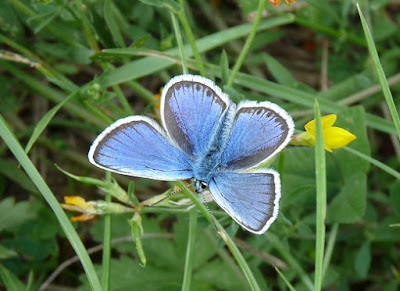I was very pleased with my two new blue species but had only had brief glimpses of a few fritillaries in flight, until I went round the outskirts of the reserve and came across this flowering bramble bush which had attracted three Marbled Fritillaries, as well as a White Admiral.
Although not a lifer, I'd only ever seen this species once, in
2015, so I took a few pictures and then moved on to my next destination on the outskirts of Virton. Here, I discovered a lovely walk which took me past this poppy field. Behind it, a farmer was mowing, attracting four Black
Kites plus a curious juvenile Red Kite.
There was also a flowering bush covered in around 40 butterflies, most of which were Meadow Browns together with at least ten Small Tortoiseshells, and one each of Green-veined White, Comma and another fritillary. This fritillary was obviously slightly different and I knew it was another new species for me but it didn't stay around long so I continued on, locating several more of them in the marshland along the River Ton.
This is Lesser Marbled Fritillary, only slightly smaller than Marbled Fritillary and very difficult to tell apart from its bigger brother. The only sure-fire way is by the colouration of one of the cells on the underwing; yellow and the same colour as the rest of the band in Lesser, a deep orange in Marbled. Here is a comparison of the two with the all-important cell highlighted.














